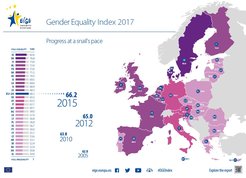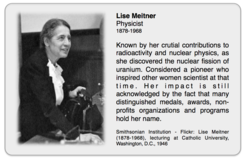Women in STEM - From counting the numbers to making the numbers count
by Alba González
In a globalized world, workplaces are becoming increasingly diverse and with this there is the challenge of adapting and providing equal opportunities to all employees. The fact is, inequalities still exist for many diversity groups, including gender differences. Corporations acknowledge that women are being paid less than their male counterparts, the so called “gender pay gap”.
Moreover, women face many challenges when they try to advance their careers, which constitute the “glass ceiling” that hinders them from climbing the corporate ladder. Considering the main benefits of a diverse working environment, which include productivity and innovation1 among other things, businesses and institutions are moving towards gender equality. They are implementing a variety of approaches that focus mostly on increasing the numbers of women in top positions. Others are more ambitious by trying complex qualitative approaches that create opportunities for women to thrive in the working environment.2 What are the prospects for gender equality in Germany? This article evaluates the current legislative framework and proposals taken both nationwide and by the Max Planck Society aiming to tackle the problem of gender inequality.
Gender Equality in Germany - Not quite
Gender equality is the state by which access to resources and opportunities is unaffected by gender.3 In Germany, gender equality is still far from being achieved, evinced by several alarming facts. For instance, the European Institute for Gender Equality placed Germany below the European average in this category.4 Even more worrisome, the Global Gender Gap Report 2008 shows that the salary gap between men and women are among the worst in Europe.5 These differences in salaries can be partially explained by the vocational choices of women that are still biased towards education and humanities, among other subjects. Moreover, the gender gap is especially wide in Engineering, Manufacturing and Construction, where only 20% of the tertiary education graduates are women.6 How is Germany dealing then with the gender and salary gaps?

Within the national legal system, Germany includes and promotes gender equality as stated in articles 3.2, 3.3 and section 3 of the 1949 Constitution.7 Lately, The Act on Equality between Women and Men in the Federal Administration and Federal Courts (Federal Equality Act) issued in 2001 supports equal opportunities at the public service level.8
In order to increase the number of women in Science, Technology, Engineering and Mathematics (STEM), several initiatives have been launched.9 For instance, “Mädchen- Zukunftstag” has focused on encouraging young women to familiarise with STEM careers and therefore, gaining their attention. Other actions focus specifically on increasing female presence in STEM by facilitating and retaining women in academia and research organizations. This is achieved by providing funding opportunities to those women in need. As an example of these efforts promoting women in STEM, individual companies and research institutions, such as the Max Planck Society (MPS), are taking the lead in enforcing gender equality through a variety of policies and initiatives.
Gender Equality at the Max Planck Society - One step at a time
The MPS is one of the leading research organizations in Germany that is advocating for gender equality. Their public report on personnel shows that the proportion of female employees was 44.3% in 2016.10 However, although this number might sound about right, the reality is that female scientists are still incredibly underrepresented in leading positions within Max Planck Research Institutes. A step closer to bridge this gap was the Central Works Council Agreement “Equal Opportunities for Women and Men at the Max Planck Society” signed in April 2008, where mandatory rules for equal opportunities were established. This agreement states that the MPS should take into account the diversity of female and male employees when making decisions and, in order to prevent discrimination. Later, in 2012, the MPS made a voluntary commitment to increase the proportion of female researchers in professorship positions (W2, W3) and in higher remuneration groups (E13 to E15) of the Collective Wage Agreement for Government Service Workers (TVöD).11 Although efforts have been made, in 2014 only 27.3% of W2 and 11.2% of W3 positions were occupied by women. The aim was to increase these by 5% more in 2017.12 This target was agreed by the Federal Ministry of Education and Research and the Joint Science Conference. Although an overall 5% increase is an ambitious target, Peter Gruss (former Max Planck President) said to his colleague directors; “I would ask you all to not only give greater consideration to applications from women, but also to proactively and with open eyes approach young female scientists who are worthy of promotion.”
Along these lines, late in 2017, the MPS came up with an initiative to keep more women as faculty by a women-only hiring process. The main purpose of this initiative is to reduce the stated underrepresentation of women in scientific research leading positions through the “Lise Meitner Excellence Program” with a budget of $35 million.13,14

Many of these initiatives are a quantitative matter, such as balancing the distribution of women and men by increasing the number of women in top positions. Counting the numbers is a first step forward towards gender equality. Exact numbers regarding the impact of these approaches, both nationwide and within the Max Planck Society remain to be seen. Women scientists are now being supported more than before, but what about disrupting the social norms, values, and ideas perpetuating these inequalities from their very base? It is clear that companies and institutions must work towards more qualitative approaches to fight gender bias. These qualitative approaches are the ones that make the numbers count, disrupt stereotypes and ultimately provide women and men with the same opportunities and access to power and resources.
This article was inspired by and created as a diversity case assignment for the Coursera MOOC “Diversity and Inclusion in the Workplace” from ESSEC Business School.
Bibliography
- Making the business case for diversity and inclusion. Strategic HR Review (2018). doi:10.1108/SHR-10-2017-0068
- Fitzpatrick, S. & Sharma, M. Can Inclusion be Measured in a Quantitative Way, Just Qualitative, or a Combination? Cornell University ILR School DigitalCommons@ILR (2017). Available at: http://digitalcommons.ilr.cornell.edu/student. (Accessed: 18th December 2018)
- Wikipedia contributors. Gender equality. Wikipedia, The Free Encyclopedia (2018). Available at: https://en.wikipedia.org/w/index.php?title=Gender_equality&oldid=872060782. (Accessed: 18th December 2018)
- Gender Equality Index 2017: Release in the Council of the EU. EIGE Available at: https://eige.europa.eu/news-and-events/events-calendar/event/9499. (Accessed: 18th December 2018)
- The Global Gender Gap Report 2008. World Economic Forum Available at: https://www.weforum.org/reports/global-gender-gap-report-2008. (Accessed: 18th December 2018)
- Venessa. Women in Science, Technology, Engineering, and Mathematics (STEM). Catalyst (2012). Available at: https://www.catalyst.org/knowledge/women-science-technology-engineering-and-mathematics-stem. (Accessed: 18th December 2018)
- Germany | Wikigender. Available at: https://www.wikigender.org/countries/europe-and-central-asia/gender-equality-in-germany/. (Accessed: 18th December 2018)
- Germany // Laws and Policies. EIGE Available at: https://eige.europa.eu/gender-mainstreaming/countries/germany/laws-and-policies. (Accessed: 18th December 2018)
- Best, K., Sanwald, U., Ihsen, S. & Ittel, A. Gender and STEM in Germany: Policies Enhancing Women’s Participation in Academia. 5, 292–304 (2013).
- Facts and Figures | Public report on personnel. Available at: https://www.mpg.de/facts-and-figures. (Accessed: 18th December 2018)
- PhD, Postdoc, and Professor Salaries in Germany - Academic Positions. Available at: https://academicpositions.com/career-advice/phd-postdoc-and-professor-salaries-in-germany. (Accessed: 18th December 2018)
- More female scientists in leading positions. Available at: https://www.mpg.de/7999136/women-science. (Accessed: 18th December 2018)
- More opportunities for female scientists. Available at: https://www.mpg.de/11767653/lise-meitner-programme. (Accessed: 18th December 2018)
- Max Planck Society Seeks to Keep More Women as Faculty. The Scientist Magazine® Available at: https://www.the-scientist.com/the-nutshell/max-planck-society-seeks-to-keep-more-women-as-faculty-30535. (Accessed: 18th December 2018)










